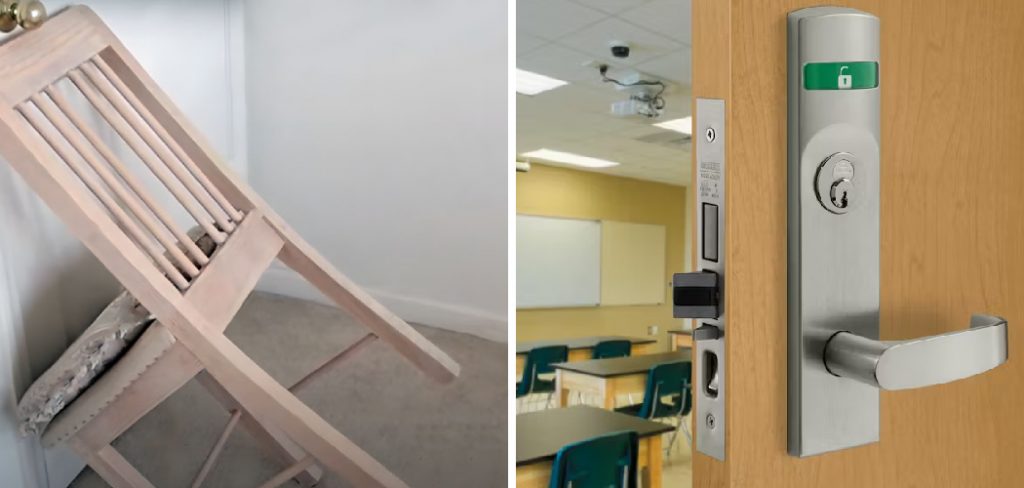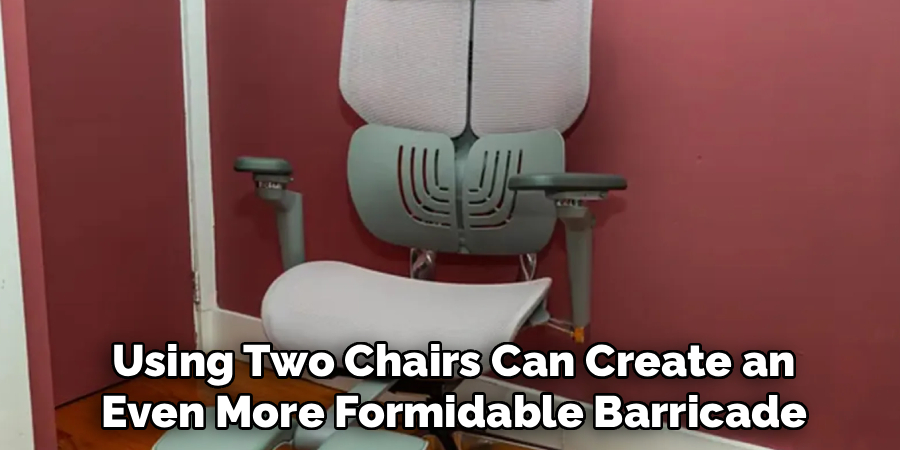In an active threat situation, securing a classroom door quickly and effectively is a critical priority. While purpose-built barricade devices are ideal, they aren’t always available. Knowing how to improvise with common objects, like a chair, can be a life-saving skill. This guide provides practical, step-by-step instructions on various methods to lock a classroom door using a chair, offering options for different door types and chair designs.

Understanding these techniques can empower educators and students to act decisively in an emergency, creating a stronger barrier and buying precious time. In this blog post, we’ll walk you through the steps on how to lock a classroom door with a chair so that you can get back to using it in no time! So grab your tools, and let’s get started!
Understand Your School’s Official Lockdown Policy
Before attempting any improvisation, it’s crucial to familiarize yourself with your school’s official lockdown policy. Most schools have specific procedures and protocols in place for ensuring the safety of students and staff during emergencies. These guidelines often include directives on how to secure doors, where to position yourself in the classroom, and how to communicate with authorities.
By understanding these protocols, you can ensure that any actions you take align with established safety measures, reducing confusion and increasing preparedness. Be sure to participate in any training sessions or drills provided by your school to stay informed and equipped to handle various scenarios effectively.
10 Methods How to Lock a Classroom Door with a Chair
1. The Classic Wedge
This is one of the simplest and most intuitive methods. The goal is to use the chair to create a tight wedge under the door, preventing it from swinging open.

This technique is most effective on doors that open inward into the classroom and have a small gap between the bottom of the door and the floor. Simply take a sturdy chair, turn it on its side, and firmly shove the top of the chair back or one of the legs under the door. The more you can force the chair underneath, the tighter the wedge will be.
A study on improvised door barricades found that even a simple wedge can significantly increase the force required to open a door. For maximum effectiveness, use the strongest part of the chair and push it in as far as it will go to create an immovable block.
2. The Horizontal Brace (for Inward-Swinging Doors)
If the door handle is a horizontal lever, you can use a chair to brace it against the wall, preventing the handle from being turned from the outside.
Position the back of a chair directly under the door handle. Then, push the chair forward until the back is wedged tightly under the lever, and the chair’s front legs are angled toward the floor.
The downward pressure on the handle from the chair back prevents it from being operated. This method works best with chairs that have a straight, flat back and a handle that is low enough to be effectively blocked. It’s a quiet and quick way to secure the handle without drawing attention.
3. The Vertical Leg Jam (for Inward-Swinging Doors)
This technique leverages the chair’s legs to create a powerful brace against the floor, stopping the door from opening. It is one of the most widely recommended improvised methods.
Place the top of the chair’s backrest securely under the doorknob or lever. Then, kick the front legs of the chair away from the door so the chair is angled downwards, with two legs firmly planted on the floor. The force of someone trying to push the door open will be transferred down the chair’s back and into the floor, creating a highly effective barricade. This method distributes pressure across the chair and floor, making it surprisingly strong. Ensure the chair legs have a good grip on the floor; this works especially well on carpeted or non-slip surfaces.
4. The Double Chair Brace
For added strength, using two chairs can create an even more formidable barricade. This method combines the principles of wedging and bracing.
First, perform the Vertical Leg Jam with one chair, placing it under the doorknob. Then, take a second chair and wedge it horizontally under the front of the first chair. This second chair acts as an anchor, preventing the first chair from slipping or buckling under pressure. The combination creates a robust, multi-point barricade that is significantly harder to breach than a single chair alone.

5. The Desk and Chair Combination
By pairing a chair with a heavy teacher’s desk, you can create a substantial barrier that is difficult for an intruder to move.
First, push the heavy desk directly in front of the inward-swinging door, leaving just enough space to maneuver. Then, use the Vertical Leg Jam method, placing a chair under the doorknob and angling it against the floor. Finally, push the desk up against the chair, adding its weight and stability to the barricade. This multi-object system combines the leveraged strength of the chair with the dead weight of the desk.
6. Securing Outward-Swinging Doors with a Chair and Cord
Outward-swinging doors present a greater challenge, as you cannot brace them from the inside. However, you can use a chair in combination with a cord, belt, or cable to secure the door’s closing mechanism.
Wedge the back of a chair against the door, right next to the frame. Loop a strong cord, extension cable, or sturdy belt through the door’s closer arm (the hydraulic bar at the top) and tie it securely to the chair.
Pull the chair back to create tension. The chair now acts as an anchor, preventing the closer arm from extending and the door from being pulled open. This requires some quick thinking and a suitable cord, but it’s one of the few effective improvised methods for this type of door.
7. The Chair as a Handle Jam (for Double Doors)
For classrooms with double doors that have two vertical bar handles, a chair can be used to lock them together.
Turn a chair horizontally and slide its back between the two handles. The top and bottom of the chair’s back should catch on the handles, preventing them from being pushed inward to open the doors. This effectively links the two doors, making it impossible to open one without the other. This technique is fast, simple, and requires no special force.
8. Lashing the Chair to the Door (for Outward-Swinging Doors)
Similar to the cord method, this technique uses a chair as an anchor but focuses on tying the handle itself to a fixed point in the room.

If the outward-swinging door has a pull-handle, you can tie a rope, belt, or cable around it. Run the other end of the rope to a heavy, immovable object in the classroom, such as a securely bolted desk or a heavy cabinet. Use a chair as a tensioning device by wedging it under the rope to keep it taut. This prevents the door from being pulled open from the outside.
9. Creating a Trip-Wire Obstacle with Chairs
While not a lock, creating a barrier of obstacles can slow down an intruder if the primary lock is breached. This creates a secondary delay.
If the door is breached, a barricade of chairs, desks, and other furniture piled in front of it can create a chaotic and difficult-to-navigate obstacle course. Scatter chairs on their sides in the entryway. The goal is to make entry slow, noisy, and difficult, giving you more time to react or escape through another exit.
10. Using a Chair Leg to Jam the Hinge
This is an unconventional last-resort method that can help secure a door, especially if the chair is broken.
If a chair is damaged or can be broken, a sturdy wooden or metal leg can be used as a jam. For an inward-swinging door, try to wedge the chair leg into the gap between the door and the frame on the hinge side. If you can force it in tightly, it can prevent the door from moving on its hinges. This is less reliable than other methods but can provide some resistance in a desperate situation.
Legal and Ethical Disclaimer
The methods described in this document are intended for informational purposes only and should only be employed in lawful and ethical circumstances.

Always ensure that these techniques are used in compliance with local laws and do not infringe upon the rights or safety of others. The authors are not responsible for any misuse of the information provided. It is crucial to prioritize safety and consider alternative, non-confrontational solutions whenever possible.
Conclusion
In any emergency, your safety is the highest priority. These methods are intended as improvised solutions when standard security measures are unavailable.
Practicing these techniques can build muscle memory and confidence, enabling a quicker and more effective response. Consider discussing these strategies with your school’s safety coordinator to incorporate them into your official emergency preparedness plan.
About
Safety Fic is a distinguished figure in the world of Diy design, with a decade of expertise creating innovative and sustainable Diy solutions. His professional focus lies in merging traditional craftsmanship with modern manufacturing techniques, fostering designs that are both practical and environmentally conscious. As the author of diy, Safety Fic delves into the art and science of Safety Fic-making, inspiring artisans and industry professionals alike.
Education RMIT University
(Melbourne, Australia) Associate Degree in Design (Safety Fic) Focus on sustainable design, industry-driven projects, and practical craftsmanship. Gained hands-on experience with traditional and digital manufacturing tools, such as CAD and CNC software.
Nottingham Trent University
(United Kingdom) Bachelor’s in diyfastly.com and Product Design (Honors) Specialized in product design with a focus on blending creativity with production techniques. Participated in industry projects, working with companies like John Lewis and Vitsoe to gain real-world insights.
Publications and Impact
In diy, Safety Fic his insights on indoor design processes, materials, and strategies for efficient production. His writing bridges the gap between artisan knowledge and modern industry needs, making it a must-read for both budding designers and seasoned professionals.
